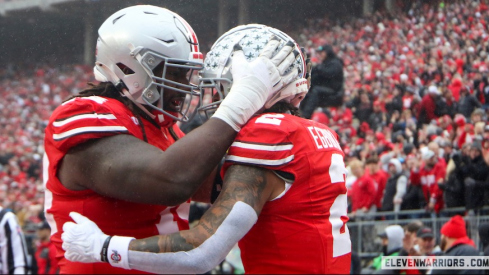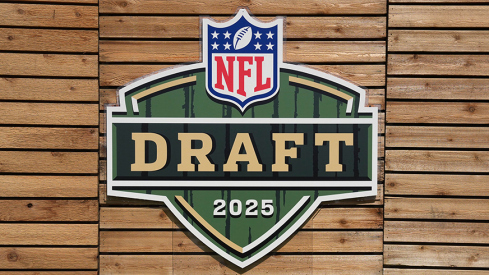
The Ohio State offense followed a familiar story line Saturday. In the face of an uber-aggressive defensive scheme, the Buckeyes stumbled when trying to consistently dropback pass in response. The Buckeye offense only got on track when they focused upon what they do best—Braxton Miller running the football. This opened up the read game and settled Miller down to become more efficient throwing the football. Miller also exhibited perhaps his best attribute—that he plays best when the chips are down and he needs to hit the accelerator. Perhaps not coincidentally, others on the Ohio State offense are exhibiting this same trait, namely Jack Mewhort and Andrew Norwell, to lead the OSU offensive line when plays need to be made.
Deja Vu All Over Again
Penn State followed the script used by most Buckeye opponents this year, namely crowd the box and blitz edge players. Ohio State often put its twins or trips to the field with TE to the boundary to try to draw PSU defenders away from the frontside run game. Penn State did not comply, however. The Nittany Lions presented OSU with either a 4-3 stack or a 3-4 look against their base personnel. Upon the snap, they generally used a basic fire zone to the field on run downs, specifically bringing both a strongside linebacker and nickel defender.
The goal was to bring additional defenders to the halfback side to check Miller on the zone read, allowing Penn State's box defenders to aggressively play the front side of the zone read and/or inverted veer.
Penn State would alternatively bring boundary edge pressure to attack Miller’s read side if OSU's halfback was to the boundary. Though they did not consistently stick to any hard and fast rules, Penn State's ultimate purpose was to, at a minimum, bring at least one additional defender on a run blitz.
Behind the zone blitz, the Nittany Lions employed a 3 deep, 3 under look. In short yardage, the Nittany Lions would get more aggressive, often bringing both safeties up to play cover-0 and sitting on the inside run game.
Wither the Response?
The Buckeyes had difficulty responding for the same reason that has plagued OSU this year—inconsistency in the passing game. Miller was inaccurate early, failing to set his feet and airmailing the football. For instance, here OSU ran a ‘levels’ pattern to attack Penn State’s cover-1. Miller set his feet and delivered a nice throw to Jake Stoneburner.
Yet later with this same route combination, Miller did not square himself and resultingly overthrew the backside curl pattern.
On a third attempt with this concept, Stoneburner again came open but Miller failed to pull the trigger, leading to a sack.
As with Purdue, the zone blitz also gave OSU and Miller troubles. The Buckeye blitz pick-up struggled because the Nittany Lions brought the blitz away from the halfback. Below, the OSU offensive line is slide-blocking to its left until the front side bubble. Carlos Hyde miscounts the rushers, however. Rather than immediately coming playside as necessary, he initially blocks backside, leading to an unblocked rusher.
Miller is then too apt to focus on the rush, rather than stepping up to deliver the football. He also seemingly refuses to scramble, even when opportunities present themselves. A defense should be putting itself at a high risk by blitzing against a QB with Miller’s running ability, because if he eludes the blitz there should be room to run. But by not exercising that option he is instead making himself vulnerable to pressure.
Interestingly, the Buckeyes seemingly continued to fail to adequately attack the flats against defenses bringing alley defenders who are vacating those areas. For instance, OSU only ran one flash screen, even though PSU did not fully commit three defenders to trips (as seen above). Furthermore, Miller is perhaps more dangerous on sprint-out and bootlegs, if for no other reason than he is more likely to run. That is not to say that OSU did not do any movement passing, merely that is seems underutilized.
Yet even when OSU did so, Miller’s early game decision-making was inconsistent. For instance, here he should clearly attack the vacated flat to Jeff Heuerman but instead attempts to force the football downfield.
As such, from the coaching staff’s perspective, there may be some hesitancy regarding whether the Buckeyes can consistently execute these plays. The coaching staff's game plan every week instead appears to be to pick a few coverage beaters that will work against the defense's coverages and execute those, keeping things simple for Miller and the offense. For instance, in the first half OSU ran levels multiple times. In the second half (as discussed below), they went to a double slant-snag combination once they had success. As Meyer has stated, it is not where they want to be as an offensive scheme, but clearly they believe that execution is currently more critical than variety.
Ohio State was thus left alternating between an inconsistent passing game and a running attack right into the teeth of the Penn State defense. The Penn State front seven also deserves credit. The Nittany Lion interior linemen in particular were able to have some success against Marcus Hall and Corey Linsley. The Nittany Lion myriad of blitzes also allowed Penn State linebackers to come unblocked and make plays.
The Buckeyes Read for Success
The Buckeyes began moving offensively by keeping Penn State off-balance in the read run game. In particular, OSU started using a version of a midline zone read to account for PSU's edge rushers. The Buckeyes would read Nittany Lion 3 and 5 techniques and then have the H-Back fan block the edge-defender.
OSU also increased the use of the frontside zone play, where the QB opens and hands to the deeper tailback and the offensive line blocks inside zone to the halfback side. This allowed OSU to attack away from where they expected the blitz to come from. And the Buckeyes began running midline from this look (for the first time I have seen), leading to both Miller touchdown runs.
OSU thus effectively mixed and matched types of zone reads to keep the Penn State blitz schemes off-balance. Miller also began executing the read game with precision, stringing together perfect reads to move the Buckeyes downfield.
As noted, OSU was also able to find a route combination that provided some consistent success in the pass game. The Buckeyes ran a double slant, snag combination. OSU put different beaters to each side to attack man coverage. The quick game allowed Miller to deliver the ball before any potential Penn State blitz. Miller then threw two perfectly placed balls.
The throw to Stoneburner was particularly impressive, as he was patient enough to allow Stoneburner to get upfield and then placed the football only where he could catch it.
Playing for all the marbles
This reflected a trait that Miller has exhibited all year. He will start slow but play his best once he starts successfully running the football. His running success not only begets more running success, but also demonstrably improves his rhythm and confidence as a passer. Miller also has impeccable timing in stepping up to make plays when OSU needs him most. When for whatever reason OSU plays a team they should beat or does need Miller to step up, he will alternatively play tentatively or over-aggressively, pre-determining his run game reads, forcing plays and the like. But when OSU needs him and Miller gets in the game's flow, he takes his game to another level. The precision in the read game was but one example. A less obvious example was this crucial third down, fourth quarter run. Penn State had just scored and OSU was in danger of going three and out. Miller lowered his shoulder, went straight upfield and gained hard yards.
This set up his throw to Stoneburner, effectively putting the game away.
Buying In
Miller was not the only Buckeye to step up his game. OSU is instead seeing guys emerge weekly, demonstrating that Meyer has the team's attention. Stoneburner is perhaps the most obvious example. Evan Spencer is another from the wide receiver position. Earlier this season, Brown and Devin Smith were the only reliable wide receiver targets. Yet over the last two weeks different receivers have stepped up to make plays. Rod Smith is another example. He is quickly emerging as perhaps the most explosive running back for Ohio State and provides a slightly different threat than Hyde. And as the third down clip demonstrates, when OSU needs a play they continue to grind behind the left side of their offensive line behind Mewhort and Norwell. Time and again they step up and make plays when needed. The upshot is that while the Buckeye offense remains somewhat limited in what it consistently executes well, players continue to step up and improve, allowing the offense to succeed.

